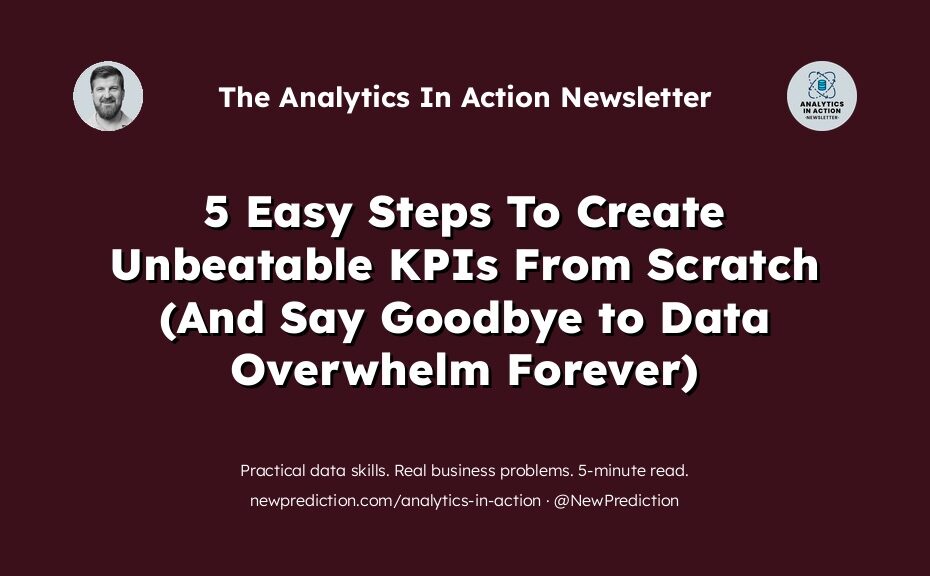Today, I’m sharing a simple yet powerful framework to help you create real business value from raw data.
This is important because, as a data analyst, you’ll always be working with some new data set. And it can be really stressful because it’s something new and there’s usually pressure to refine that raw data into something useful.
But there are insights in the raw data. If you know how to get them out.
Unfortunately, most beginners never get to the insights. They lack awareness that insights even exist! They stay stuck and overwhelmed. And they continue on with confusing priorities.
Thanks to Gigasheet for sponsoring this week’s Starting with Data newsletter
 | Data too big for Excel? Try Gigasheet.Quickly sort, filter, and group multi-gigabyte files with no database or coding. From huge CSVs to complex JSON files, Gigasheet makes exploratory data analysis easy. Sign up and get 3GB free. |
Most data professionals underestimate the value of KPIs.
They fail to fully grasp how powerful high-quality KPIs can be:
- Inability to adapt
- Zero data insights
- Unclear objectives
- Ineffective-decision making
- Overlooking key business initiates
But this step-by-step guide will take you through the proven framework I’ve used with clients over the past 15 years.
Step 1: Set crystal-clear goals
You have to begin with a strong vision.
But don’t overcomplicate this step. You can start off with something simple like “increase landing page conversion rates by 25%”. Success starts with knowing your exact target.
With a specific goal established, your journey is self-guiding.
You can use that overall goal as a “north star”. If you are feeling lost (or – the more likely scenario – your boss gives you more work!) you can always return to that one specific goal.
Rookie mistakes
The number one thing to watch out for with goal setting is being vague. Instead, you want to be specific.
- Vague: get more email subscribers
- Specific: increase email signup landing page conversion rates from 20% to 25% over the next 3 months.
As a data professional, you have to be ruthless on this point.
Because people will be giving you all sorts of ideas. Fortunately, you’ve got the power at your fingertips: the ability to work with data using SQL and other data analytics tools.
Goal setting is a critical step and it’s something that you can learn over time.
The important thing is getting started and taking that first step.
Step 2: Choose the best tool for the job
The right tools make everything easy.
If you already have the data available (like in a database or some Excel worksheets) then your job is pretty easy. But a lot of times, you have to get the data yourself. This can seem daunting but it’s a necessary step to develop high-quality KPIs.
For our landing page conversion rate example, you may need to do a data extract from Google Analytics to get page traffic details (number of visitors, time on page, etc.)
Or you may have a landing page builder with built-in analytics from the vendor.
Salesforce, HubSpot, and other marketing platforms have this kind of functionality built in. If you’re not sure where to start, check in with a colleague.
The bottom line is you want to get the data and get it into a database so you can use SQL to uncover hidden gems.
Rookie mistakes
Don’t get bogged down with too many tools.
Pick one or two that will help you get the job done. For example, work to get your database set up (Tool #1) and then use SQL to develop the analysis (Tool #2). You can get very far with just this approach.
Don’t overthink this step.
Remember, it’s about building high-quality KPIs, not showing of your skills.
Step 3: Uncover hidden gems (quickly)
Building great KPIs starts with working through data quickly.
For example, I can quickly look at a data set with dozens of columns and thousands of rows and immediately start picking out what metrics and KPIs could be created.
- revenue and expenses → profit ratio
- sales and customer data → avg customer sales
- website visits and registrations → conversion rates
Rookie mistakes
You don’t need to know all of the statistics to create great metrics.
Unfortunately, I get this question all the time. Beginners think that knowing how to do linear regressions are somehow required to start working through data problems. But that couldn’t be further from the truth!
In fact, you just need basic business math to start working with raw data.
And then let the results speak for themselves.
Step 4: Zero in on the potential KPIs
Next, you have to pick metrics that will make a difference.
This might be the hardest step because it takes intuition and experience. But both of those come with time. The more work you put in, the better (and faster) this will become for you.
And it’s the key to growing your career in data.
Because you’ll be able to see raw data and figure out what to actually DO with it way before anyone else. This is what I mean when I say that “knowing how to work with data is like a superpower”. It’s true!
Here’s how you do it:
- Start with the basics: Conversion rates, profit ratios, customer sales (mentioned above) are good ones for marketing and sales. Cost per click, customer lifetime value, and return on ad spend are good ones too.
- Spot check your work: Once you’ve created some KPIs, check your work. I usually go through a few records to make sure that the numbers line up as expected. This saves rework (and embarrassment) down the line.
- Focus on quality over quantity: I recommend no more than 5 metrics for any initiative or product. Any more than that, and it’s impossible to keep up. In fact, I’ll usually recommend just one or two primary KPIs and then just three or four secondary KPIs that all support the one or two primary ones.
Step 5: Monitor, adjust, and improve
The final step in the framework is to keep a close eye on your work.
Over time, you can continue to monitor the KPIs you’ve created and adjust accordingly. For example, if you’ve created a conversion rate metric but found that you need to exclude a traffic source for some reason, simply update your metric definition (while properly communicating it) and continue reporting.
This is how you keep things moving forward and improving over time.
Because tracking progress and making changes when new information comes along is what leads you to success with your KPIs at the end.
Rookie mistakes to avoid
Don’t become complacent, assuming that “all is well” with your KPIs or that “no news is good news”. As a data professional, it’s your responsibility to make sure things are tracking as expected and alerting your client or your boss when they aren’t.
Be prepared to pivot when needed.
If you want to succeed in digital marketing analytics, you really need to stay agile and learn to develop high-quality KPIs quickly.
And you can use the 5-Step KPI Creation Framework as a proven method to get you there.
The 5-Step KPI Creation Framework
- Step 1: Set crystal-clear goals
- Step 2: Choose the best tool for the job
- Step 3: Uncover hidden gems (quickly)
- Step 4: Zero in on the potential KPIs
- Step 5: Monitor, adjust, and improve
